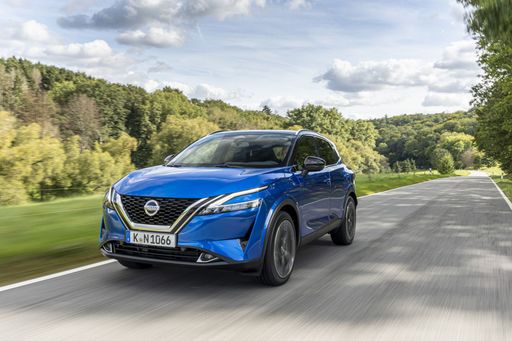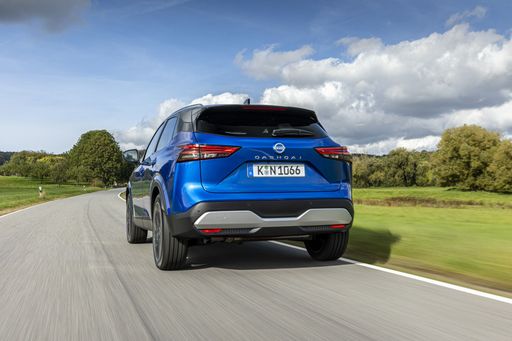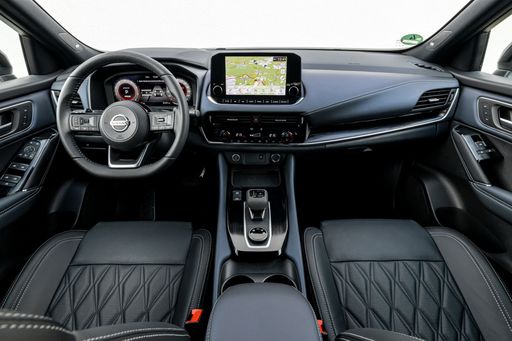The automotive market is a vibrant battleground, especially in the SUV segment where models like the Alfa Romeo Junior and Nissan Qashqai are fighting for supremacy. Both vehicles cater to the modern driver's need for versatility, style, and performance. In this article, we will delve into a comprehensive comparison of these two remarkable SUVs, focusing on their technical specifications and innovative features.
Alfa Romeo Junior vs Nissan Qashqai – Which car suits you better?
Two cars, one duel: Alfa Romeo Junior meets Nissan Qashqai.
Which one wins in performance, efficiency and value for money? Find out now!
Design and Dimensions
The Alfa Romeo Junior boasts a compact yet bold silhouette measuring 4,173 mm in length, 1,781 mm in width, and standing at a height of 1,533 mm. Its design is unmistakably Italian, featuring sleek lines and an aggressive stance that highlights its sporty nature.
On the other hand, the Nissan Qashqai is slightly larger, measuring 4,425 mm in length and 1,835 mm in width, with a height of 1,625 mm. This added size translates into a roomier cabin and a more commanding presence on the road. While the Qashqai treads a more conventional design path, it still exudes a modern aesthetic with sharp angles and a refined appearance.
Power and Performance
The Alfa Romeo Junior offers a variety of engine options, including a standout electric variant with a driving range of up to 410 km. The petrol MHEV versions come with power outputs ranging from 136 HP to an impressive 280 HP. Performance-wise, it can accelerate from 0 to 100 km/h in as little as 5.9 seconds, showcasing its sporty DNA.
In comparison, the Nissan Qashqai’s engine lineup also includes petrol MHEV and full hybrid options, producing between 140 HP and 190 HP. It achieves a 0 to 100 km/h time of 7.9 seconds, offering swift performance, though slightly less aggressive than the Junior's best-in-class acceleration.
Fuel Efficiency and Emissions
Efficiency is a pivotal consideration for buyers today. The Alfa Romeo Junior shines in this category, with fuel consumption figures as low as 4.5 L/100km for petrol variants, alongside its electric models consuming 15.2 kWh/100km. This translates to lower CO2 emissions, with values reaching as low as 0 g/km in the electric version, promoting a greener footprint.
The Nissan Qashqai, while not as efficient as the Junior, still holds its own with a respectable consumption ranging from 5.1 to 6.8 L/100km. Its emissions range from 116 g/km, showcasing an environmentally conscious design but still trailing behind the Junior in terms of sustainability.
Interior and Technology
Inside, both SUVs are equipped to impress. The Alfa Romeo Junior comes with a modern cabin designed with high-quality materials, ergonomics, and a suite of tech innovations. The vehicle features an automatic transmission across its range with options for dual-clutch systems, enhancing driver engagement and efficiency.
The Nissan Qashqai rises to the occasion with a spacious interior laden with modern technology, including an intuitive infotainment system and driver-assist features. It offers both manual and automatic transmission options, giving drivers the choice based on their preferences.
Practicality and Comfort
Practicality is another strong suit for both models. The Junior provides a trunk capacity of 400 liters, a respectable amount for everyday use. Meanwhile, the Qashqai excels in this aspect with a trunk capacity of 504 liters, making it a more suitable option for families or those needing more cargo space.
Both vehicles comfortably accommodate five passengers, and the variety of configurations in both models provides choices for different lifestyles and preferences.
Conclusion
In the battle between the Alfa Romeo Junior and the Nissan Qashqai, both SUVs bring something unique to the table. The Junior captivates with its striking design, sporty performance, and impressive efficiency. Meanwhile, the Qashqai champions practicality and a wealth of technology, making it a solid choice for family-oriented buyers.
Ultimately, your choice between these two will depend on whether you prioritize performance and style or practicality and technology. Whichever you choose, both models represent the continuing evolution of the SUV segment, catering to diverse needs and tastes in today’s automotive landscape.
Here’s where it gets real: The technical differences in detail
Costs and Efficiency:
When it comes to price and running costs, the biggest differences usually appear. This is often where you see which car fits your budget better in the long run.
Alfa Romeo Junior has a to a small extent advantage in terms of price – it starts at 25700 £, while the Nissan Qashqai costs 29400 £. That’s a price difference of around 3720 £.
Fuel consumption also shows a difference: Alfa Romeo Junior manages with 4.80 L and is therefore minimal more efficient than the Nissan Qashqai with 5.10 L. The difference is about 0.30 L per 100 km.
Engine and Performance:
Power, torque and acceleration are the classic benchmarks for car enthusiasts – and here, some clear differences start to show.
When it comes to engine power, the Alfa Romeo Junior has a clearly perceptible edge – offering 280 HP compared to 190 HP. That’s roughly 90 HP more horsepower.
In acceleration from 0 to 100 km/h, the Alfa Romeo Junior is distinct quicker – completing the sprint in 5.90 s, while the Nissan Qashqai takes 7.90 s. That’s about 2 s faster.
There’s no difference in top speed – both reach 206 km/h.
There’s also a difference in torque: Alfa Romeo Junior pulls hardly perceptible stronger with 345 Nm compared to 330 Nm. That’s about 15 Nm difference.
Space and Everyday Use:
Whether family car or daily driver – which one offers more room, flexibility and comfort?
Both vehicles offer seating for 5 people.
In curb weight, Alfa Romeo Junior is minimal lighter – 1380 kg compared to 1420 kg. The difference is around 40 kg.
In terms of boot space, the Nissan Qashqai offers a bit more room – 504 L compared to 415 L. That’s a difference of about 89 L.
In maximum load capacity, the Nissan Qashqai performs a bit better – up to 1447 L, which is about 167 L more than the Alfa Romeo Junior.
When it comes to payload, Nissan Qashqai slightly takes the win – 520 kg compared to 420 kg. That’s a difference of about 100 kg.
Who wins the race?
The Alfa Romeo Junior proves to be has a very small edge and therefore becomes our DriveDuel Champion!
Alfa Romeo Junior is the better all-rounder in this comparison.

Alfa Romeo Junior
Alfa Romeo Junior
The Alfa Romeo Junior captures the essence of Italian design with its sleek lines and compact dimensions, making it an icon of elegance and performance. With a spirited driving experience and a charming retro aesthetic, it appeals to enthusiasts and casual drivers alike. This delightful car embodies the brand's rich heritage while remaining a fun and engaging option for those seeking a unique automotive experience.
details @ media.stellantis.com
@ media.stellantis.com
 @ media.stellantis.com
@ media.stellantis.com
 @ media.stellantis.com
@ media.stellantis.com
Nissan Qashqai
The Nissan Qashqai stands out in the compact SUV market with its sleek design and versatile features. Its smooth ride and refined interior make it a popular choice for both city driving and weekend adventures. Advanced safety technologies and user-friendly infotainment add to its appeal, ensuring a comfortable and secure driving experience for all passengers.
details @ Nissan
@ Nissan
 @ Nissan
@ Nissan
 @ Nissan
@ Nissan
 @ Nissan
@ Nissan
 @ Nissan
@ Nissan

|

|
|
|
|
Costs and Consumption |
|
|---|---|
|
Price
25700 - 41600 £
|
Price
29400 - 42500 £
|
|
Consumption L/100km
4.8 - 5.4 L
|
Consumption L/100km
5.1 - 6.8 L
|
|
Consumption kWh/100km
15.1 - 17.5 kWh
|
Consumption kWh/100km
-
|
|
Electric Range
344 - 410 km
|
Electric Range
-
|
|
Battery Capacity
0.4 - 51 kWh
|
Battery Capacity
-
|
|
co2
0 - 119 g/km
|
co2
116 - 154 g/km
|
|
Fuel tank capacity
44 - 45 L
|
Fuel tank capacity
55 L
|
Dimensions and Body |
|
|---|---|
|
Body Type
SUV
|
Body Type
SUV
|
|
Seats
5
|
Seats
5
|
|
Doors
5
|
Doors
5
|
|
Curb weight
1380 - 1689 kg
|
Curb weight
1420 - 1665 kg
|
|
Trunk capacity
340 - 415 L
|
Trunk capacity
479 - 504 L
|
|
Length
4173 mm
|
Length
4425 mm
|
|
Width
1781 mm
|
Width
1835 mm
|
|
Height
1505 - 1538 mm
|
Height
1625 mm
|
|
Max trunk capacity
1205 - 1280 L
|
Max trunk capacity
1422 - 1447 L
|
|
Payload
390 - 420 kg
|
Payload
466 - 520 kg
|
Engine and Performance |
|
|---|---|
|
Engine Type
Electric, Petrol MHEV
|
Engine Type
Petrol MHEV, Full Hybrid
|
|
Transmission
Automatic
|
Transmission
Manuel, Automatic
|
|
Transmission Detail
Dual-Clutch Automatic, Reduction Gearbox
|
Transmission Detail
Manual Gearbox, CVT, Reduction Gearbox
|
|
Drive Type
Front-Wheel Drive, All-Wheel Drive
|
Drive Type
Front-Wheel Drive, All-Wheel Drive
|
|
Power HP
136 - 280 HP
|
Power HP
140 - 190 HP
|
|
Acceleration 0-100km/h
5.9 - 9.1 s
|
Acceleration 0-100km/h
7.9 - 10.2 s
|
|
Max Speed
150 - 206 km/h
|
Max Speed
170 - 206 km/h
|
|
Torque
230 - 345 Nm
|
Torque
240 - 330 Nm
|
|
Number of Cylinders
3
|
Number of Cylinders
3 - 4
|
|
Power kW
100 - 207 kW
|
Power kW
103 - 140 kW
|
|
Engine capacity
1199 cm3
|
Engine capacity
1332 - 1497 cm3
|
General |
|
|---|---|
|
Model Year
2024 - 2025
|
Model Year
2024
|
|
CO2 Efficiency Class
A, C, D
|
CO2 Efficiency Class
E, D
|
|
Brand
Alfa Romeo
|
Brand
Nissan
|
What drive types are available for the Alfa Romeo Junior?
Available configurations include Front-Wheel Drive or All-Wheel Drive.
The prices and data displayed are estimates based on German list prices and may vary by country. This information is not legally binding.
